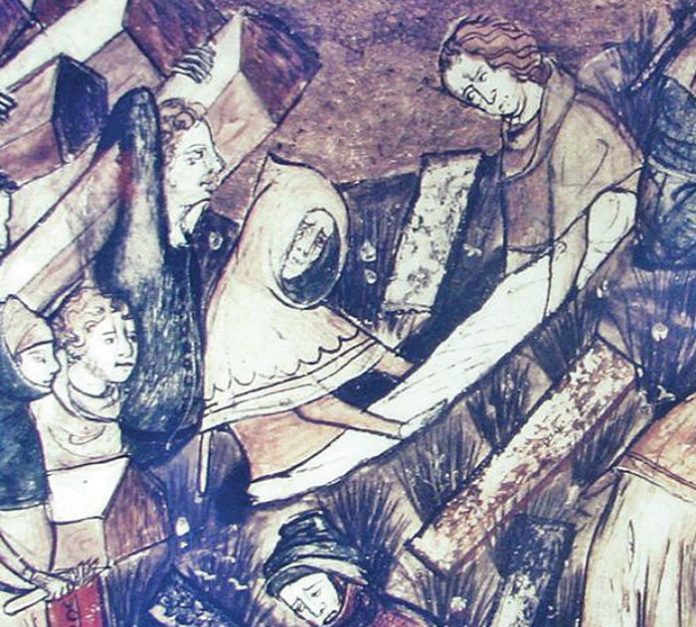One of the oldest Haggadahs in the world can be found today in Jerusalem. This ancient manuscript is composed of 36 pages and is almost seven centuries old. It has traveled through the ages from Provence in southern France to its current location, where it has found peace. The Haggadah is written on thick, high-quality parchment in the fancy, ornate letters of a sofer. In the margins are listed ancient customs written by the French scholar Rabbi Yaakov ben Shlomo Tzarfati.
One of the most beautiful and prominent pages contains the story of the ten plagues with which Hakadosh Baruch Hu afflicted the Egyptians. But in the margins, between stains that may be water or tears and others that may be wine or blood, Rabbi Yaakov wrote penetrating words that scream out in pain, adding to the timeless words of the Haggadah his anguish about the horrific plague of his day, which killed three of his children; they died in severe agony from the black spots that covered their bodies.
This is the horrific story of one of the most horrible epidemics that mankind has ever experienced. It defied borders, destroyed cities and altered the face of Western history. It caused huge destruction among the Ashkenazi Jewish communities, changing them forever.
This is the story of the Haggadah of Rabbi Yaakov Tzarfati, written while the plague was consuming Europe. Despite incredible personal tragedy, he continued to spread the words of the Torah in the face of the horrors surrounding him.
In 1347, Messina was a busy seaport in Sicily, the equivalent of a bustling airport in our day. Ships navigated their way to the docks, workers loaded and unloaded goods, and passengers came and went, trading news from the farthest reaches of the known world. There were rumors that in the faraway lands of silk and paper, an epidemic was raging; entire cities across the seas were reportedly desolate.
One day, 12 ships appeared on the horizon, returning from a voyage, the flag of Genoa flying on their masts. No one really noticed as dozens of sailors were taken off the ships on stretchers. They were suffering from a strange malady, with dark purple lumps on their skin and a terrible stench emanating from their bodies. They were extremely weak and had high fever.
The sailors were taken straight to the hospital, where doctors examined them, drained their blood, and smeared their pustules with salves and ointments. Nonetheless, the sailors died in agony within a few days. They were hurriedly buried in one of the churchyards, and it seemed that the strange affair was over as quickly as it had begun.
What no one knew was that the sailors had brought with them the Angel of Death, an invisible passenger that would ravage Europe. The Black Plague had arrived from China and spread its wings over Italy, just like the coronavirus epidemic of today. The plague began to weave its web of death.
The Black Plague, also known as the Black Death because it blackened the victim’s skin, is considered the deadliest epidemic in history, killing about 30 million Europeans in the fourteenth century—between a quarter and a half of Europe’s population. (Many millions more died in Asia, but there is little documentation from those regions.)
Like the coronoavirus, the plague broke out in China and found its way across Asia when the Mongols engaged in campaigns to conquer the Eurasian tribes. They found themselves in the Crimean Peninsula, where they used the bodies of their comrades who had died of the plague as weapons against their enemies, possibly the first known case of biological warfare. Italian cargo ships then carried the disease from the Black Sea to the ports of southern Europe.
The consequences were disastrous. Whole villages disappeared from the map; London and Paris became wastelands, and piles of bodies lined the roads across the continent. The plague struck everyone equally—nobles and serfs, peasants and priests. Churches filled up with crowds who came to pray for salvation and exacerbated the plague by spreading it.
When King Philip VI of France asked medical experts at the University of Paris to explain to him the cause of the epidemic, they said that it was due to an unusual astrological configuration of Saturn, Jupiter and Mars. As a solution, they tried a number of options, including various magic potions, drinking mercury, and drowning chickens—especially black ones. They also advocated for the killing of black cats, or any cats, which were “known” to be in cahoots with the devil.
What those doctors did not know was that the cause was a bacteria, Yersinia pestis, which is spread by fleas that acquire the bacteria from infected rodents. Bites from infected fleas quickly spread the plague to the human population. When cats were eliminated, things got worse—no cats, more rodents.
Across Europe, villages sat deserted and untended crops rotted in fields, resulting in mass famine and adding to the death toll. People with the illness were isolated, locked away in their houses to die alone. Corpses piled up everywhere; bodies were burned, filling the air with rancid smoke.
With the cats dead, the chickens depleted, and the potions useless, Europe turned to the traditional remedy for all that ailed them—blaming the Jews. Rumors were started that the Jews were poisoning the wells. Jews were arrested and brutally tortured until they were forced to plead guilty.





















